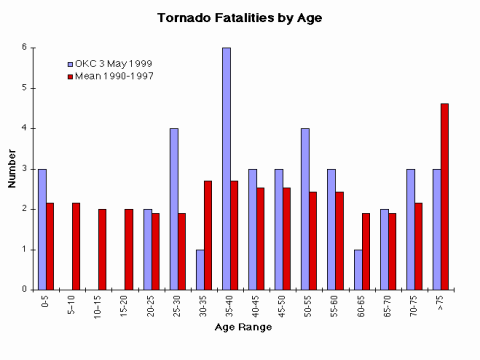| front |1 |2 |3 |4 |5 |6 |7 |8 |9 |10 |11 |12 |13 |14 |15 |16 |17 |18 |19 |20 |21 |22 |23 |24 |25 |26 |27 |28 |29 |30 |31 |32 |33 |review |
 |
One of the more
intriguing aspects of the demographics of fatalities associated with the
Oklahoma City tornado is the absence of any deaths from the age of 5 through
23 years old. If we compare this to the average distribution of deaths from
other tornadoes in the 1990s, the gap is striking. If we assume that
the 1990s distribution represents the typical distribution of deaths by age
associated with tornadoes, we can estimate how likely it is that the gap
associated with the Oklahoma City tornado would occur by chance. To do so,
we randomly select 36 ages from the distribution associated with the 1990s,
and repeat for a large number of trials. The result is that the probability
of such a gap is less than 1 in 3000. There are many possible reasons for the gap. One is that there were few residents of damaged structures in that age range. We do not have complete demographic information on the residents of the damaged houses (note that data on the level of census tracts would be unable to resolve the affected housing), but information is available from one subset of the damage track. Officials of the Moore Public Schools, whose district includes much of the damage track in south Oklahoma City and Moore, estimated that there were approximately 1800 students from their schools that lived in houses that were either seriously damaged or destroyed by the tornado (S. Couch 1999, personal communication). Thus, it seems unlikely that the tornado preferentially traveled through a region of few students. Only 6 of the 1800 Moore students were hospitalized, and none were killed. Another possible reason for this gap is education of the
students. An informal survey of 130 junior high school students in two of
the Moore schools with the largest numbers of damaged structures, conducted
2 weeks after the tornado, indicated that approximately 85% of the students
took some precautionary actions (e.g., going into an interior bathroom or
closet). Of those, all but one sought shelter in locations recommended by
NationalWeather Service guidance. Seventy percent of the students surveyed
indicated that they had learned tornado safety precautions as part of their
education at school (S. Couch and K. Parrish 1999, personal communication).
At one of the schools, tornado safety had been covered as part of the
eighth-grade earth science classes on the Friday before the tornado hit on
Monday. Although we cannot prove a causal relationship, it is plausible to
suggest that education of school children was a strong contributor to the
absence of fatalities among that age group. |